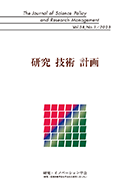Volume 38, Issue 4
Displaying 1-13 of 13 articles from this issue
- |<
- <
- 1
- >
- >|
Preface
-
Article type: Preface
2024Volume 38Issue 4 Pages 370-373
Published: February 29, 2024
Released on J-STAGE: March 07, 2024
Download PDF (299K)
Special Issue: Evidence Base Policy Making (EBPM) in Science, Technology and Innovation Policy
-
Article type: Special Issue
2024Volume 38Issue 4 Pages 374-377
Published: February 29, 2024
Released on J-STAGE: March 07, 2024
Download PDF (319K) -
Article type: Special Issue
2024Volume 38Issue 4 Pages 378-392
Published: February 29, 2024
Released on J-STAGE: March 07, 2024
Download PDF (1243K) -
Article type: Special Issue
2024Volume 38Issue 4 Pages 393-405
Published: February 29, 2024
Released on J-STAGE: March 07, 2024
Download PDF (495K) -
Article type: Special Issue
2024Volume 38Issue 4 Pages 406-419
Published: February 29, 2024
Released on J-STAGE: March 07, 2024
Download PDF (1194K) -
Article type: Special Issue
2024Volume 38Issue 4 Pages 420-432
Published: February 29, 2024
Released on J-STAGE: March 07, 2024
Download PDF (713K) -
Article type: Special Issue
2024Volume 38Issue 4 Pages 433-444
Published: February 29, 2024
Released on J-STAGE: March 07, 2024
Download PDF (767K) -
Article type: Special Issue
2024Volume 38Issue 4 Pages 445-459
Published: February 29, 2024
Released on J-STAGE: March 07, 2024
Download PDF (935K)
Article
-
Article type: Article
2024Volume 38Issue 4 Pages 460-475
Published: February 29, 2024
Released on J-STAGE: March 07, 2024
Download PDF (1226K) -
Article type: Article
2024Volume 38Issue 4 Pages 476-493
Published: February 29, 2024
Released on J-STAGE: March 07, 2024
Download PDF (890K) -
Article type: Article
2024Volume 38Issue 4 Pages 494-506
Published: February 29, 2024
Released on J-STAGE: March 07, 2024
Download PDF (930K)
Occasional Series: General Trend of Innovation Research: Review from Seminal Research
-
Article type: Occasional Series
2024Volume 38Issue 4 Pages 507-512
Published: February 29, 2024
Released on J-STAGE: March 07, 2024
Download PDF (276K)
Editor's note
-
Article type: Editor's note
2024Volume 38Issue 4 Pages 513
Published: February 29, 2024
Released on J-STAGE: March 07, 2024
Download PDF (140K)
- |<
- <
- 1
- >
- >|
